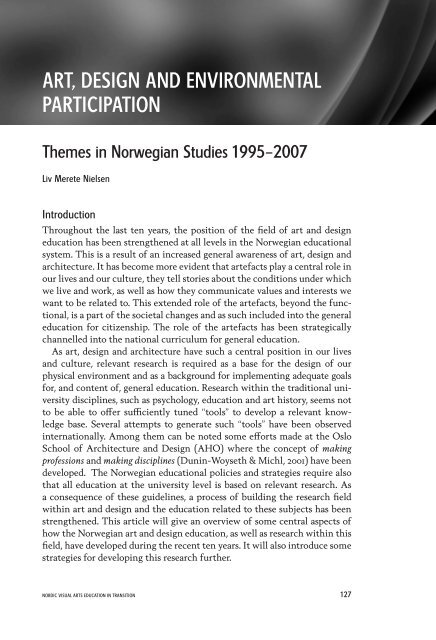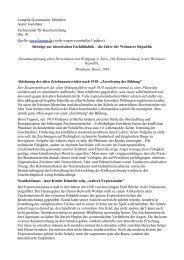Research in Visual Arts Education - The National Society for ...
Research in Visual Arts Education - The National Society for ...
Research in Visual Arts Education - The National Society for ...
You also want an ePaper? Increase the reach of your titles
YUMPU automatically turns print PDFs into web optimized ePapers that Google loves.
ART, DESIGN AND ENVIRONMENTAL<br />
PARTICIPATION<br />
<strong>The</strong>mes <strong>in</strong> Norwegian Studies 1995–2007<br />
Liv Merete Nielsen<br />
Introduction<br />
Throughout the last ten years, the position of the field of art and design<br />
education has been strengthened at all levels <strong>in</strong> the Norwegian educational<br />
system. This is a result of an <strong>in</strong>creased general awareness of art, design and<br />
architecture. It has become more evident that artefacts play a central role <strong>in</strong><br />
our lives and our culture, they tell stories about the conditions under which<br />
we live and work, as well as how they communicate values and <strong>in</strong>terests we<br />
want to be related to. This extended role of the artefacts, beyond the functional,<br />
is a part of the societal changes and as such <strong>in</strong>cluded <strong>in</strong>to the general<br />
education <strong>for</strong> citizenship. <strong>The</strong> role of the artefacts has been strategically<br />
channelled <strong>in</strong>to the national curriculum <strong>for</strong> general education.<br />
As art, design and architecture have such a central position <strong>in</strong> our lives<br />
and culture, relevant research is required as a base <strong>for</strong> the design of our<br />
physical environment and as a background <strong>for</strong> implement<strong>in</strong>g adequate goals<br />
<strong>for</strong>, and content of, general education. <strong>Research</strong> with<strong>in</strong> the traditional university<br />
discipl<strong>in</strong>es, such as psychology, education and art history, seems not<br />
to be able to offer sufficiently tuned “tools” to develop a relevant knowledge<br />
base. Several attempts to generate such “tools” have been observed<br />
<strong>in</strong>ternationally. Among them can be noted some ef<strong>for</strong>ts made at the Oslo<br />
School of Architecture and Design (AHO) where the concept of mak<strong>in</strong>g<br />
professions and mak<strong>in</strong>g discipl<strong>in</strong>es (Dun<strong>in</strong>-Woyseth & Michl, 2001) have been<br />
developed. <strong>The</strong> Norwegian educational policies and strategies require also<br />
that all education at the university level is based on relevant research. As<br />
a consequence of these guidel<strong>in</strong>es, a process of build<strong>in</strong>g the research field<br />
with<strong>in</strong> art and design and the education related to these subjects has been<br />
strengthened. This article will give an overview of some central aspects of<br />
how the Norwegian art and design education, as well as research with<strong>in</strong> this<br />
field, have developed dur<strong>in</strong>g the recent ten years. It will also <strong>in</strong>troduce some<br />
strategies <strong>for</strong> develop<strong>in</strong>g this research further.<br />
NORDIC VISUAL ARTS EDUCATION IN TRANSITION 127



